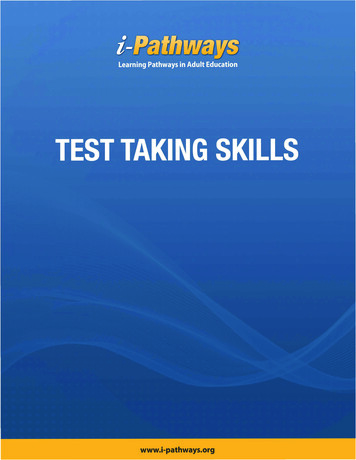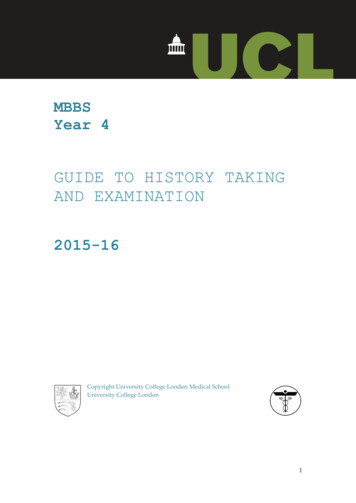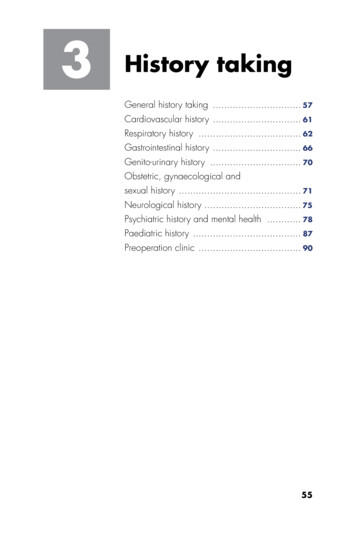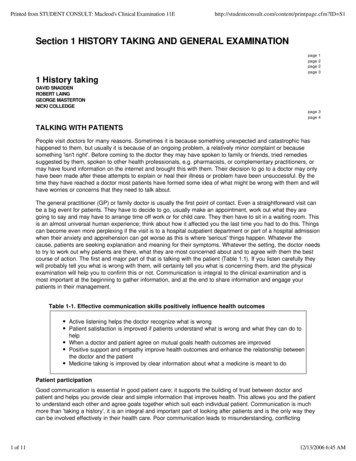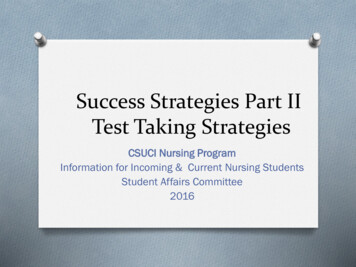
Transcription
Success Strategies Part IITest Taking StrategiesCSUCI Nursing ProgramInformation for Incoming & Current Nursing StudentsStudent Affairs Committee2016
The PurposeO To prepare students for test takingO To develop skill in applying knowledge topractice relating to test takingO To help reduce test anxietyO To learn success tips from high performingstudents.Students are encouraged to view Powerpoint titled:Success Strategies Part I on Student Success Strategies
Preparing for an examO Identify important ideas in the readings/assignmentsO Identify content that serves to accomplish the learningOOOOOobjectives of the courseStudents should be building new information on whatthey know alreadyCreate practice questionsBalance study with sleep, healthy meals and exerciseEat before the exam (food will give you energy)Seek help from professors, tutors or mentor students
ResourcesO Textbook Resources:O NCLEX Practice Questions: End of chapter & online resourcesfor text booksO Online Resources: NCLEX Tips Online at http://www.nclexonline.com/tips/ 6 Tips for Nursing Students to Pass Exams udents-to-passthe-exam ****Test Taking Techniques athttp://www.austincc.edu/health/ttt/ **** TestTakingTips.com for insights for a variety of different testingformats (multiple choice, true-false, short answer,)
Why, Oh Why?And What is the Purpose?O Well designed multiple choice questions allow forengagement and evaluation in application ofknowledge to nursing practiceO Multiple choice questions enhance and evaluatecritical thinkingO Optimal patient outcomes are effected by the ability ofnurses’ to critically thinkColleen Nevins, RN, MN, DNP, Test Taking Tips, 2014
All in the PrepLearn the content to understand relevancy topractice versus memorizing, which requires: Reading the assigned material Practicing test questions Discussion with others, e.g., group work Questioning and seeking more information -By asking why, when, where, who, how?Colleen Nevins, RN, MN, DNP, Test Taking Tips, 2014
The BIG QuestionNCLEX Style Question Components:1. Stem: scenario and presentation of issue (key words)1. Question: what the question is asking2. Distractors: incorrect but possible answers3. Key Words: set the direction of care or response
#2–SampleQuestionSample NCLEX QuestionsStem: In passing the physician for your patient in the hospital hall, hesmiles and mentions he will be ordering an x-ray. You enter thepatient's room to find her crying. She states "Dr. X was so abrupt andrude. I have never been treated so badly. I want to talk to asupervisor.“Question: As the nurse, your best initial response is?Distractors:1. “What level of supervisor do you want to talk to?”2. “Dr. X is always rude to everyone. Don’t take it personally.”3. “What do you want to talk to a supervisor about? Perhaps I canhelp.”4. Correct Answer: “You seem upset.”Colleen Nevins, RN, MN, DNP, Test Taking Tips, 2014
Look #2for- Cuesin AnswersIncorrectvs. CorrectResponsesINCORRECT Do not promotecommunication Discounts patient’s feelings May make patient feelinadequate or defensiveCORRECT Promotes opencommunication Use of paraphrasing Acknowledges patient’sfeelingsColleen Nevins, RN, MN, DNP, Test Taking Tips, 2014
Cues in Key Words#3 - Key Words Always Most likely or least likely Initial Priority or best Every Entire Only Never or rarely
Test Tips#4 - Tips Read test question carefully. What is the question asking? Do not read into the scenario or question.Read the responses carefully.Re-read the scenario, question, and responses.Delete the obvious incorrect responses.Move onto the next question, and come back tothe question if stuck.
Tips #5 -ThinkMaslow!AnswerOptions#1. AirwayBreathingCirculation#2. Safety/Disability#3. Communication#4. Nursing ProcessColleen Nevins, RN, MN, DNP, Test Taking Tips, 2014
Question/Answer SampleQuestion: As a nurse, which of the following is your firstpriority of providing care?Answers:1. Patient needs a dressing change2. Patient needs suctioning3. Patient is in pain4. Patient is incontinentAfter answering, now place each in order of priority Colleen Nevins, RN, MN, DNP, Test Taking Tips, 2014
Question/Answer SampleQuestion: As a nurse, which of the following is your firstpriority of providing care?Answers in order of priority:#4. Patient needs a dressing change#1. Patient needs suctioning#2. Patient is in pain#3. Patient is incontinentColleen Nevins, RN, MN, DNP, Test Taking Tips, 2014
Question/Answer Options#5elements:- AnswerO Importantpatient Options(age, gender, race);issue or medical problem (patho); details(signs/symptoms, medications, surgery); time (earlyor late, pre- or post-op surgery)O If unsure, make an educated guess byO Eliminating distractors, which can increase your correctchoice of options by @ 25 - 30%O If choice is between 2 answers, choose the most logical orcommon sense response; 50 – 50 chance of being correctColleen Nevins, RN, MN, DNP, Test Taking Tips, 2014
Remember: Not all ExamQuestions will be NCLEXO The following slides will provide basicinformation for answering:O Multiple Choice QuestionsO True False QuestionsO Short Answer QuestionsO Open Book Exam Questions
Basic Info for AnsweringMultiple Choice QuestionsO Go through the test once and answer all the questionsOOOOyou canGo through test again, spend a reasonable amount oftime on each question, then move on if you get stuckIf you are stuck, try to reason the correct answer fromgeneral concept or theoryResearch shows that students gain more than they loseif they change an answer (Kruger et al., 2005)Save time at the end to double-check answers andensure there are no clerical or numbering errorsTestTakingTips.com, Multiple Choice Test Tips-Help Retrieved February 2016
Basic Information for AnsweringTrue-False QuestionsO Usually there are more true answers than falseO You have 50% chance of getting the right answer ifOOOOguessingRead through each statement carefullyPay attention to qualifiers like “never, always, and every”mean that the statement must be true “all of the time”Qualifiers like “usually, sometimes and generally” meanthat the statement can be considered true or falsedepending on the circumstancesIf any part of the questions is false, then the entirestatement is falseTestTakingTips.com, True-False Test Tips-Help Retrieved February 2016
Basic Information forShort-Answer QuestionsO Use flashcards; write key terms, dates and conceptsO Try to anticipate questions that will be asked on thetest and prepare for themO Usually what your instructor emphasizes in class willbe on the testO Try not to leave an answer blank. Show yourwork/write down your thoughts, even if you don’t getthe exact answerO If you can think of more than one answer for aquestion, ask the instructor to clarifyTestTakingTips.com, Short Answer Test Tips-Help Retrieved February 2016
Basic Information for takingOpen-Book TestsO Spend an equal or great amount of time preparing as youOOOOOwould for a normal test.Open book tests are most likely to be harderFamiliarize yourself with the book and assigned materialFocus on learning the main ideas and get a feel for wherethey are located in the book and/or your notes.Answer the easy questions you know off the top of yourheadDo not expect you will have time to look up every singleanswer. Most are timed and you cannot look up each inthe time allotted.TestTakingTips.com, Open Book Test Tips-Help Retrieved February 2016
Reduce Test Taking Anxiety(excessive worry about doing well on a test)O Being well prepared for the testO Space out studying over a few days and continuallyOOOOOreview materialsMaintain a positive attitude while preparingStress reducing activities (yoga, exercise,meditation)Show up to class early to reduce worry of being lateRead directions slowly and carefullyIf you do not understand the directions, askTestTakingTips.com, Test Taking Anxiety Tips-Help Retrieved February 2016
Top Performing Students Reportthe following tips:O Regularly attend classO Pay attention in classO Read strategically (skim; focus on introductions,conclusion and highlighted/boxed texts; payattention to readings mentioned in classO Spread out studying, as opposed to crammingO Seek help from campus resourcesGross Davis, B., Tools for Teaching, Second Edition, Jossey-Bass
Study Strategies (Continued)O Study in a quiet environment (few distractions)O Study with others who are well prepared and canhelp each otherO Get enough sleepO Vary study activities (re-read text, notes, rewriteclass notes, memorize information, pose questionswhile studyingGross Davis, B., Tools for Teaching, Second Edition, Jossey-Bass
Focus on SuccessColleen Nevins, RN, MN, DNP, Test Taking Tips, 2014
ReferencesGross Davis, Barbara, Tools for Teaching, Second Edition, 2009,Jossey-Bass,San Francisco, pp375-386O Kruger,J., Wirtz, D., and Miller, D.T. “Counterfactual Thinking and First InstinctFallacy” Journal of Personality and Social Psychology, 2005, 88(5), 725-735O Nevins RN, MN, DNP, C., Test Taking Tips, 2014 ,O Sherwood, G., Horton-Deutsch, S., Reflective Organizations on the Front lines ofQSEN & Reflective Practice implementation, 2015, Sigma Theta TauInternational, pp38-42O
The Purpose O To prepare students for test taking O To develop skill in applying knowledge to practice relating to test taking O To help reduce test anxiety O To learn success tips from high performing students. Students are encouraged to view Powerpoint titled

